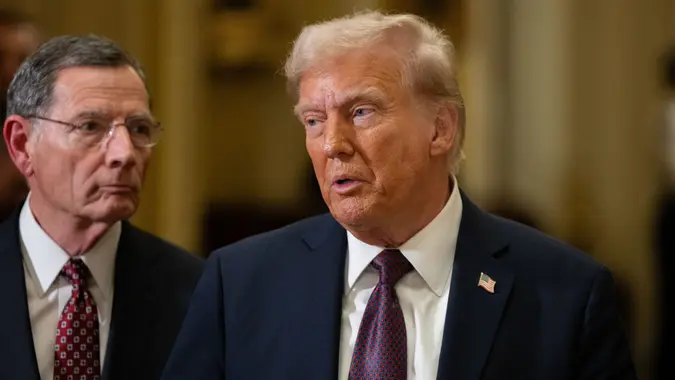5 Ways Trump’s First and Second Terms Could Be Different for Retirees

Commitment to Our Readers
GOBankingRates' editorial team is committed to bringing you unbiased reviews and information. We use data-driven methodologies to evaluate financial products and services - our reviews and ratings are not influenced by advertisers. You can read more about our editorial guidelines and our products and services review methodology.

20 Years
Helping You Live Richer

Reviewed
by Experts

Trusted by
Millions of Readers
From expanding Medicare Advantage benefits to providing tax cuts, President-elect Donald Trump’s first term brought significant changes to retirement policies and reflected a mix of reforms and fiscal priorities. The approach of his second term, dawning in just over a week, raises questions about the evolution and impact of his retirement policies.
“If Trump pursues changes to federal programs or tax policies in a second term, retirees might face risks like cuts to Social Security, Medicare or healthcare access,” said Christopher Stroup, the founder and president of Silicon Beach Planning. “Potential benefits could include tax reductions or more favorable policies on retirement savings. This may result in increased disposable income and investment growth in the long term.”
Here are five ways Trump’s first and second terms could be different for retirees.
Tax Breaks on Social Security Income
Trump pledged during his 2024 campaign to eliminate federal taxes on Social Security income.
Overall, if Trump fulfills his campaign promise, it could put more money in the pockets of retirees, especially those who live in states with no or low income taxes.
Uncertainty About Social Security’s Future
In an interview with AARP, Trump was adamant that he would “protect” Social Security through boosting the nation’s economic growth.
However, Trump is closer to the edge of Social Security’s fiscal cliff. Federal analysts estimate that the Social Security Trust Fund will be able to pay all of the total scheduled benefits until 2033. Unless Congress acts soon, the fund’s reserves will be depleted, and retirees could see only 79% of their benefit checks.
“President Trump has indicated that he is not going to reform Medicare or Social Security,” said Wayne Winegarden, an economist at the Pacific Research Institute. “This is problematic, because both programs are on financially unsustainable paths. Without reforms, retiree benefits will be cut significantly.”
More or Continued Tax Breaks
In addition to eliminating the tax on Social Security benefits, Trump said he would continue or make permanent many of the tax cuts he enacted during his first term that are set to expire this year.
During Trump’s first term, many retirees benefitted from tax code changes that lowered their tax rates, preserved favorable tax rates for long-term capital gains and qualified dividends, and doubled federal estate and gift exemptions.
Enhanced Investment Opportunities
The passage of the Setting Every Community Up for Retirement Enhancement (SECURE) Act during Trump’s first term expanded retirement savings opportunities. Specifically, the law increased the required minimum distribution (RMD) age to 72 and made it easier for retirement plans to offer annuities.
“I would expect to see more of what we experienced during the first administration — active encouragement for Americans to take more personal responsibility for their retirement plans,” said Paul Tyler, host of “That Annuity Show.”
Tyler explained, “A second administration could possibly require employers to make annuity contributions part of the default investment portfolio to guarantee supplemental income for more retirees in the future.”
Investment experts said retirees should weigh their options if Trump continues to deregulate the financial sector during his second term.
“Retirees could see continued deregulation, potentially enhancing options,” Stroup said. “This change could possibly come at the cost of more risk and fewer protections.”
Lower Drug Costs
Trump’s first term was marked by efforts to repeal the Affordable Care Act (ACA), reduce overall program spending and enact Medicaid and Medicare reforms.
“During Trump’s first term, his administration expanded Medicare Advantage and attempted to lower prescription drug prices through executive actions,” Stroup said. “In a second term, we might see continued efforts to reduce drug costs and expand access to private Medicare plans. However, comprehensive reforms would face significant political challenges.”
Trump proposed reforming the role of pharmacy benefit managers (PBMs) to reduce prescription drug prices by eliminating the “middle man,” which he said contributed to inflated drug costs.
While the last Congress almost passed PBM reforms, a second Trump term could see a renewed push for increasing price transparency, lowering costs to insurance and mandating all negotiated discounts to insurers, rather than PBMs keeping the money for themselves, Winegarden said.
“Right now, because of the adverse incentives of the drug pricing system, too much of the drug costs are being shifted to patients,” Winegarden said. “This inflates out-of-pocket costs for patients. Reconsidering this bill would be a positive change that could help lower patients’ health care spending on drugs.”
Editor’s note on political coverage: GOBankingRates is nonpartisan and strives to cover all aspects of the economy objectively and present balanced reports on politically focused finance stories. You can find more coverage of this topic on GOBankingRates.com.
 Written by
Written by  Edited by
Edited by 

























